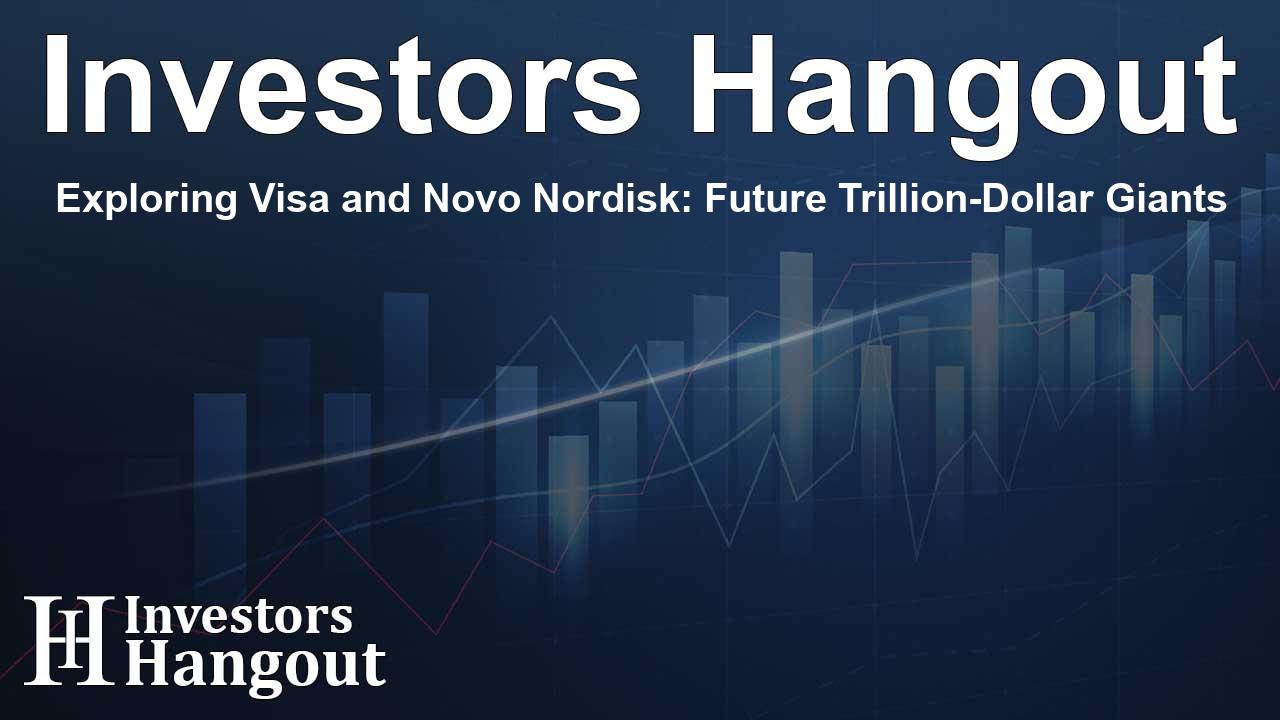Exploring Visa and Novo Nordisk: Future Trillion-Dollar Giants

Understanding the Path to a Trillion-Dollar Market Cap
Reaching a market cap of $1 trillion is a notable accomplishment that very few companies have achieved. This exclusive club primarily comprises technology titans like Nvidia, Meta Platforms, Apple, Amazon, and Microsoft. As the landscape evolves, more companies are anticipated to join these ranks. Among those that may soon become members are Visa and Novo Nordisk, both of which are showing promising trajectories. This analysis delves into how these companies could make it to a trillion-dollar valuation by the year 2030.
Visa: A Major Contender
Boasting one of the largest payment networks globally, Visa stands at the forefront of the financial services industry. It processes millions of transactions daily, benefiting from an ongoing shift away from cash towards digital payments. With a current market cap of just under $550 billion, Visa needs to achieve a compound annual growth rate (CAGR) of approximately 10.5% by 2030 to attain a trillion-dollar evaluation. Fortunately, Visa has a proven track record, having consistently outperformed this growth rate in recent years.
Competitive Landscape and Market Position
Visa's status as a market leader in the payment sector is largely undisputed, with Salesforce as its primary competitor. The company's robust network effects amplify its value: as more consumers adopt Visa-branded cards, the value of this network increases for merchants, thereby creating an advantageous cycle that reinforces Visa's market dominance.
Growth Opportunities Aboard
Despite high credit card penetration in developed regions, there's untapped potential in emerging markets, suggesting ample room for growth. Visa has identified a $20 trillion opportunity across various payment methods. Considering its recent revenue of about $35 billion, the prospect for expansion is significant, positioning Visa for further revenue and stock price growth akin to its past performance.
Novo Nordisk: Breaking into New Markets
As the landscape shifts, Novo Nordisk currently holds a market cap of around $400 billion. For it to join the trillion-dollar club, a CAGR of about 16.5% would be imperative. This might seem daunting, yet Novo Nordisk has consistently shown remarkable performance, especially with its flagship products like Wegovy and Ozempic, which have revolutionized treatments for obesity and diabetes respectively. The company is at the heart of the burgeoning GLP-1 weight loss market, which is gaining traction among pharmaceutical firms.
Market Projections and Revenue Potential
Analysts predict that the weight loss drug market could soar to $150 billion by the early 2030s, a significant increase from its $24 billion valuation last year. Despite potential competition, the pipeline of Novo Nordisk remains robust, featuring innovative treatments like an oral medicine called amycretin and CagriSema, projected to generate up to $20.2 billion in revenue.
Future Innovations on the Horizon
Entering the later part of this decade, Novo Nordisk is set to gain essential regulatory approvals on several projects, fortifying its position to continue delivering impressive financial results. Its capability to potentially reach a trillion-dollar valuation by 2030 seems well within reach, thanks to sustained growth in therapeutic areas.
Investing in Visa: Is It Worth It?
Potential investors should weigh their options carefully before committing to Visa. While various investment services have identified plenty of stocks with the potential for substantial returns, it is essential to consider the future landscape and market dynamics. Investing wisely involves understanding both current market positions and future potential for growth.
Frequently Asked Questions
What is the significance of a $1 trillion market cap?
A $1 trillion market cap signals a company's strong market presence and financial performance, indicating significant investor confidence.
How does Visa maintain its competitive edge?
Visa leverages its extensive network and global acceptance of its cards, which creates strong network effects beneficial for both consumers and merchants.
What are GGLP-1 medicines?
GLP-1 medicines like Wegovy and Ozempic are weight loss and diabetes treatments that have gained attention for their efficacy, contributing significantly to Novo Nordisk's growth.
Can Novo Nordisk achieve a $1 trillion valuation?
With a solid product pipeline and expanding market, Novo Nordisk has the potential to reach a $1 trillion valuation by 2030.
What should investors consider when looking at these stocks?
Investors should evaluate each company's growth potential, market opportunities, and financial health before making investment decisions.
About The Author
Contact Lucas Young privately here. Or send an email with ATTN: Lucas Young as the subject to contact@investorshangout.com.
About Investors Hangout
Investors Hangout is a leading online stock forum for financial discussion and learning, offering a wide range of free tools and resources. It draws in traders of all levels, who exchange market knowledge, investigate trading tactics, and keep an eye on industry developments in real time. Featuring financial articles, stock message boards, quotes, charts, company profiles, and live news updates. Through cooperative learning and a wealth of informational resources, it helps users from novices creating their first portfolios to experts honing their techniques. Join Investors Hangout today: https://investorshangout.com/
The content of this article is based on factual, publicly available information and does not represent legal, financial, or investment advice. Investors Hangout does not offer financial advice, and the author is not a licensed financial advisor. Consult a qualified advisor before making any financial or investment decisions based on this article. This article should not be considered advice to purchase, sell, or hold any securities or other investments. If any of the material provided here is inaccurate, please contact us for corrections.
